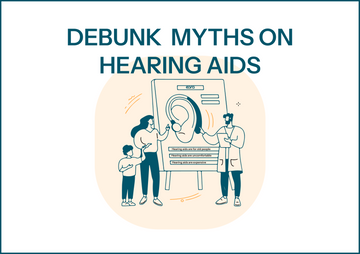You've probably heard many things about hearing aids; some good, some bad, and some just plain wrong. Maybe you think they're uncomfortable, clunky, too expensive or they won't work for your type of hearing loss. Sounds familiar?
These myths and misconceptions have existed for years, and unfortunately, they keep a lot of people from taking that first step towards better hearing.
But here's the thing, modern Bluetooth hearing aids are nothing like what you might have imagined. They're smart, discreet, and designed to integrate with your everyday life. Yet too many people still hesitate due to outdated myths.
It's time to set the record straight. Let's break down the biggest myths about Bluetooth hearing aids and uncover the truth, so you can confidently decide if they're right for you.
Myth 1: Hearing aids are just for the elderly

When you hear the words hearing aid, what’s the first image that pops into your head? Probably an older person, right? That’s because age is one of the strongest predictors of hearing loss, especially for people between 60 and 69 years of age. As we age, the tiny hair cells in our inner ear naturally degrade, making it harder to pick up certain sounds. So yes, hearing loss is common among older adults.
Still, hearing loss doesn’t discriminate by age. Millions of young people also experience hearing loss due to factors like genetics, infections, and exposure to loud noise. And one of the biggest culprits? Personal listening devices (PLDs - headphone, earphones and earbuds) and loud entertainment venues.
Over 1 billion young people worldwide are at risk of permanent hearing damage due to unsafe listening habits. Occupational Safety and Health Administration (OSHA) allows 8 hours of exposure at 90 dB (about as loud as a large boiler room), but the safe exposure time cuts in half with every 5 dB increase. Meanwhile, most young people listen to personal listening devices (PLDs) at an average of 105 dB, and most concerts on average reach 112 dB, exposing them to dangerous noise levels.
Want to learn more about how noise exposure affects your hearing? Check out these studies on safe listening levels and the global impact of unsafe listening habits.
Myth 2: Hearing aids will restore your hearing to normal
Bluetooth hearing aids can greatly enhance daily life, but they don’t cure hearing loss. They amplify sounds and enhance clarity, making conversations easier but they cannot restore natural hearing.
Their effectiveness depends entirely on the type and severity of each user's hearing loss. For mild to moderate cases, OTC hearing aids can significantly improve communication. But for severe hearing loss, sounds may still feel different because once the inner ear’s tiny hair cells are damaged, they don’t regenerate. Plus, the brain needs time to adapt to these new changes in sounds.
With the right hearing aids and expert tuning, patients experience significant improvements in their ability to hear and connect with the world. Eara Hearing's audiologists are available to guide you, set realistic expectations, and help you find the best solution for your needs.
Myth 3: Hearing Aids Are Uncomfortable and Bulky

There was a time when hearing aids were anything but discreet. Picture this: large, beige-colored devices that hooked around the ear, thick plastic molds that didn’t quite sit right. These early models were bulky, uncomfortable, and not exactly subtle. They did the job, but at the cost of both comfort and aesthetics.
But modern Bluetooth hearing aids? They’re completely different. Sleek, lightweight, and designed for comfort, today’s models are a world apart from their clunky predecessors. Take the self-fitting OTC Bluetooth Eara Explore Li+ hearing aids, for example: small, about the size of a paperclip. It includes multiple dome sizes (extra small to extra large) made from premium, soft silicone for a secure, comfortable, and nearly invisible fit. Whether you prefer open or closed domes, it’s built for all-day comfort without that bulky, outdated feel.
Myth 4: Hearing Aids Will Make You Seem Old
For years, people have worried that wearing hearing aids makes them look older; but ironically, untreated hearing loss can have that exact effect. Struggling to follow conversations, constantly asking people to repeat themselves, or withdrawing from social situations can make someone seem disconnected and aged beyond their years.
Thankfully, awareness campaigns and shifting attitudes around hearing health are helping break the stigma. Just like glasses are embraced for vision, hearing aids are becoming a normal part of self-care. They keep you engaged, confident, and socially active-traits that make you younger, not older.
Myth 6: Hearing Aids Are Too Expensive
Hearing aids used to come with a hefty price tag, but that’s no longer the case. Thanks to OTC (over-the-counter) options, costs have dropped significantly, making hearing aids more accessible than ever. OTC hearing aids are designed for mild to moderate hearing loss and some like the Eara Explore Li+ are self-fitting, meaning you don’t need to visit an audiologist for adjustments, saving both time and money.
Insurance coverage for hearing aids has also been improving, making them even more affordable for many people. Check out our other blog post that covers Medicare and hearing aid coverage in detail.
And if you’re looking for a premium yet affordable option, our self-fitting Explore Li+ hearing aid is just $699 - a fraction of what traditional prescription models cost. Plus, we offer a 45-day risk-free trial, so you can experience better hearing with zero commitment.
Myth 7: Hearing Aids Emit Unpleasant Feedback Sounds
If you’ve ever heard that high-pitched whistling from an old hearing aid, you know exactly where this myth comes from. Older models struggled to process sound properly, often creating annoying feedback that could make wearing them frustrating.
Thankfully, those days are over. Some Modern Bluetooth hearing aids have built-in feedback control, meaning no more unexpected squeaks or whistles. Today’s technology automatically detects and eliminates feedback before it even happens so you can enjoy clear, comfortable sound.
Moving Beyond Myths with Bluetooth Hearing Aids
Hearing aids have come a long way, not just in technology and design but also in acceptance. While modern devices are sleek, comfortable, and packed with features like Bluetooth streaming and self-fitting options, the biggest shift has come from open conversations and awareness. The more we talk about hearing health, the more we break the stigma.
If you’ve been putting off a hearing check, now’s the time to take action. Start with a quick free online hearing test or book a free audiological consultation to get expert guidance.
Meet the best OTC Bluetooth hearing aids - The Eara Explore Li+

Looking for a discreet, high-tech hearing aid that fits seamlessly into your lifestyle? Explore Li+ delivers crystal-clear sound, Bluetooth streaming, and a companion app for self-fitting, all in a lightweight, comfortable design. Plus, with our 45-day risk-free trial, you can experience better hearing with zero worries. Check it out here.
Let’s keep spreading positive awareness about hearing health because staying connected to the world around you should never be a luxury.
























